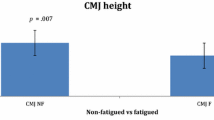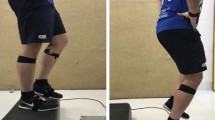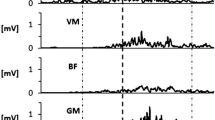Abstract
Load-dependant adjustments in lateral jumps are thought to rely on foot placement and on upper leg’s kinematic and neuromuscular adaptations. The aim of this study was to elucidate task-specific adjustments during the initial impact phase under varying stretch-loads by the comparison of lateral jumps and lateral landings. Ten subjects performed lateral jumps and landings from four distances. Electromyographic (EMG) data of five lower extremity muscles were measured, whilst lower extremity kinematics and kinetics were analysed by 3D motion analysis. Lateral jumps were characterized by increased impact forces, higher lower extremity joint moments with exception of the initial knee abduction moment, greater sagittal knee and hip joint displacements, and a further exorotated foot placement. In lateral landings frontal ankle and hip joint displacements were greater. Thigh muscle and m. tibialis anterior (TA) pre-activity as well as initial post-impact EMG were higher in lateral jumps than in lateral landings, whilst during the reflex-induced phase thigh and shank muscle EMG, except for TA, were enhanced in lateral jumps. From these findings it can be concluded that task specificity in lateral jumps in contrast to lateral landings impedes a stretch-load adequate modulation of initial impact forces which particularly affects ankle joint loading. Foot placement seems to play a decisive role for limiting lateral ankle and medial knee joint loading. Therefore, in sports containing high-impact frontal plane movements a special emphasis in training routines should be paid to foot placement strategy in those movements. Such training interventions might contribute to injury prevention in lateral movements.







Similar content being viewed by others
References
Avela J, Santos PM, Komi PV (1996) Effects of differently induced stretch-loads on neuromuscular control in drop jump exercise. Eur J Appl Physiol Occup Physiol 72:553–562
Brown TN, Palmieri-Smith RM, Mclean SG (2009) Sex and limb differences in hip and knee kinematics and kinetics during anticipated and unanticipated jump landings: implications for anterior cruciate ligament injury. Br J Sports Med 43:1049–1056
Davis RB, Iunpuu S, Tyburski D, Gage JR (1991) A gait analysis data collection and reduction technique. Hum Mov Sci 10:575–587
Devita P, Skelly WA (1992) Effect of landing stiffness on joint kinetics and energetics in the lower-extremity. Med Sci Sports Exerc 24:108–115
Duncan A, McDonagh MJ (2000) Stretch reflex distinguished from pre-programmed muscle activations following landing impacts in man. J Physiol 526:457–468
Dyhre-Poulsen P, Simonsen EB, Voigt M (1991) Dynamic control of muscle stiffness and H reflex modulation during hopping and jumping in man. J Physiol 437:287–304
Fleischmann J, Gehring D, Mornieux G, Gollhofer A (2010) Load-dependent movement regulation of lateral stretch shortening cycle jumps. Eur J Appl Physiol 110:177–187
Fong DT, Chan YY, Mok KM, Yung PS, Chan KM (2009) Understanding acute ankle ligamentous sprain injury in sports. Sports Med Rehabil Ther Technol 30:1–14
Ford KR, Myer GD, Smith RL, Vianello RM, Seiwert SL, Hewett TE (2006) A comparison of dynamic coronal plane displacement between matched male and female athletes when performing single leg landings. Clin Biomech 21:33–40
Grood ES, Suntay WJ (1983) A joint coordinate system for the clinical description of three-dimensional motions: application to the knee. J Biomech Eng 105:136–144
Hermens HJ, Freriks B, Disselhorst-Klug C, Rau G (2000) Development of recommendations for SEMG sensors and sensor placement procedures. J Electromyogr Kinesiol 10:361–374
Hertel J (2002) Functional anatomy, pathomechanics, and pathophysiology of lateral ankle instability. J Athl Train 37:364–375
Hewett TE, Myer GD, Ford KR, Heidt RS, Colosimo AJ, Mclean SG, van den Bogert AJ, Paterno MV, Succop P (2005) Biomechanical measures of neuromuscular control and valgus loading of the knee predict anterior cruciate ligament injury risk in female athletes. Am J Sports Med 33:492–501
Ho CS, Lin CJ, Chou YL, Su FC, Lin SC (2000) Foot progression angle and ankle joint complex in preschool children. Clin Biomech 15:271–277
Hoffer JA, Andreassen S (1981) Regulation of soleus muscle stiffness in premammillary cats: intrinsic and reflex components. J Neurophysiol 45:267–285
Horita T, Komi PV, Nicol C, Kyrolainen H (2002) Interaction between pre-landing activities and stiffness regulation of the knee joint musculoskeletal system in the drop jump: implications to performance. Eur J Appl Physiol 88:76–84
Jones D, Louw Q, Grimmer K (2000) Recreational and sporting injury to the adolescent knee and ankle: prevalence and causes. Aust J Physiother 46:179–188
Kadaba MP, Ramakrishnan HK, Wootten ME (1990) Measurement of lower extremity kinematics during level walking. J Orthop Res 8:383–392
Komi PV, Gollhofer A (1997) Stretch reflexes can have an important role in force enhancement during SSC exercise. J Appl Biomech 13:451–460
Krosshaug T, Nakamae A, Boden BP, Engebretsen L, Smith G, Slauterbeck JR, Hewett TE, Bahr R (2007) Mechanisms of anterior cruciate ligament injury in basketball: video analysis of 39 cases. Am J Sport Med 35:359–367
Leukel C, Gollhofer A, Keller M, Taube W (2008) Phase- and task-specific modulation of soleus H-reflexes during drop-jumps and landings. Exp Brain Res 190:71–79
Ludvig D, Cathers I, Kearney RE (2007) Voluntary modulation of human stretch reflexes. Exp Brain Res 183:201–213
Mclean SG, Lucey SM, Rohrer S, Brandon C (2010) Knee joint anatomy predicts high-risk in vivo dynamic landing knee biomechanics. Clin Biomech (Bristol, Avon) 25:781–788
McNitt-Gray JL (1993) Kinetics of the lower extremities during drop landings from three heights. J Biomech 26:1037–1046
Mrdakovic V, Ilic DB, Jankovic N, Rajkovic Z, Stefanovic D (2008) Pre-activity modulation of lower extremity muscles within different types and heights of deep jump. J Sports Sci Med 7:269–278
Nicol C, Komi PV (1998) Significance of passively induced stretch reflexes on achilles tendon force enhancement. Muscle Nerve 21:1546–1548
Nigg BM, Liu W (1999) The effect of muscle stiffness and damping on simulated impact force peaks during running. J Biomech 32:849–856
Olsen OE, Myklebust G, Engebretsen L, Bahr R (2004) Injury mechanisms for anterior cruciate ligament injuries in team handball: a systematic video analysis. Am J Sports Med 32:1002–1012
Recondo JA, Salvador E, Villanua JA, Barrera MC, Gervas C, Alustiza JM (2000) Lateral stabilizing structures of the knee: functional anatomy and injuries assessed with MR imaging. Radiographics 20:91–102
Santello M (2005) Review of motor control mechanisms underlying impact absorption from falls. Gait Posture 21:85–94
Santello M, McDonagh MJ (1998) The control of timing and amplitude of EMG activity in landing movements in humans. Exp Physiol 83:857–874
Sinkjaer T, Toft E, Andreassen S, Hornemann BC (1988) Muscle stiffness in human ankle dorsiflexors: intrinsic and reflex components. J Neurophysiol 60:1110–1121
Sousa F, Ishikawa M, Vilas-Boas JP, Komi PV (2007) Intensity- and muscle-specific fascicle behavior during human drop jumps. J Appl Physiol 102:382–389
Wu G, Siegler S, Allard P, Kirtley C, Leardini A, Rosenbaum D, Whittle M, D’Lima DD, Cristofolini L, Witte H, Schmid O, Stokes H (2002) ISB recommendation on definitions of joint coordinate system of various joints for the reporting of human joint motion-part 1: ankle, hip, and spine. J Biomech 35:543–548
Yeow CH, Lee PV, Goh JC (2009) Regression relationships of landing height with ground reaction forces, knee flexion angles, angular velocities and joint powers during double-leg landing. Knee 16:381–386
Yeow CH, Lee PV, Goh JC (2010) Sagittal knee joint kinematics and energetics in response to different landing heights and techniques. Knee 17:127–131
Author information
Authors and Affiliations
Corresponding author
Additional information
Communicated by Jean-René Lacour.
Rights and permissions
About this article
Cite this article
Fleischmann, J., Gehring, D., Mornieux, G. et al. Task-specific initial impact phase adjustments in lateral jumps and lateral landings. Eur J Appl Physiol 111, 2327–2337 (2011). https://doi.org/10.1007/s00421-011-1861-z
Received:
Accepted:
Published:
Issue Date:
DOI: https://doi.org/10.1007/s00421-011-1861-z




